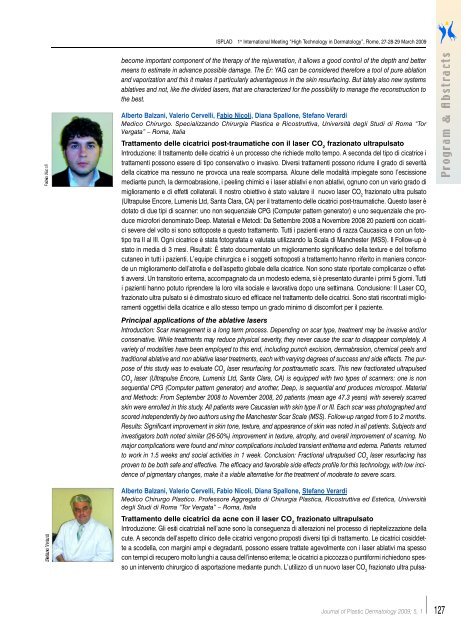Vol. 5, n. 1, January-March 2009 1th International ... - Salute per tutti
Vol. 5, n. 1, January-March 2009 1th International ... - Salute per tutti
Vol. 5, n. 1, January-March 2009 1th International ... - Salute per tutti
You also want an ePaper? Increase the reach of your titles
YUMPU automatically turns print PDFs into web optimized ePapers that Google loves.
ISPLAD 1 st <strong>International</strong> Meeting “High Technology in Dermatology”, Rome, 27-28-29 <strong>March</strong> <strong>2009</strong><br />
become important component of the therapy of the rejuvenation, it allows a good control of the depth and better<br />
means to estimate in advance possible damage. The Er: YAG can be considered therefore a tool of pure ablation<br />
and vaporization and this it makes it particularly advantageous in the skin resurfacing. But lately also new systems<br />
ablatives and not, like the divided lasers, that are characterized for the possibility to manage the reconstruction to<br />
the best.<br />
Alberto Balzani, Valerio Cervelli, Fabio Nicoli, Diana Spallone, Stefano Verardi<br />
Medico Chirurgo. Specializzando Chirurgia Plastica e Ricostruttiva, Università degli Studi di Roma “Tor<br />
Vergata” – Roma, Italia<br />
Trattamento delle cicatrici post-traumatiche con il laser CO 2 frazionato ultrapulsato<br />
Introduzione: Il trattamento delle cicatrici è un processo che richiede molto tempo. A seconda del tipo di cicatrice i<br />
trattamenti possono essere di tipo conservativo o invasivo. Diversi trattamenti possono ridurre il grado di severità<br />
della cicatrice ma nessuno ne provoca una reale scomparsa. Alcune delle modalità impiegate sono l’escissione<br />
mediante punch, la dermoabrasione, i peeling chimici e i laser ablativi e non ablativi, ognuno con un vario grado di<br />
miglioramento e di effetti collaterali. Il nostro obiettivo è stato valutare il nuovo laser CO 2 frazionato ultra pulsato<br />
(Ultrapulse Encore, Lumenis Ltd, Santa Clara, CA) <strong>per</strong> il trattamento delle cicatrici post-traumatiche. Questo laser è<br />
dotato di due tipi di scanner: uno non sequenziale CPG (Computer pattern generator) e uno sequenziale che produce<br />
microfori denominato Deep. Materiali e Metodi: Da Settembre 2008 a Novembre 2008 20 pazienti con cicatrici<br />
severe del volto si sono sottoposte a questo trattamento. Tutti i pazienti erano di razza Caucasica e con un fototipo<br />
tra II al III. Ogni cicatrice è stata fotografata e valutata utilizzando la Scala di Manchester (MSS). Il Follow-up è<br />
stato in media di 3 mesi. Risultati: È stato documentato un miglioramento significativo della texture e del trofismo<br />
cutaneo in <strong>tutti</strong> i pazienti. L’equipe chirurgica e i soggetti sottoposti a trattamento hanno riferito in maniera concorde<br />
un miglioramento dell’atrofia e dell’aspetto globale della cicatrice. Non sono state riportate complicanze o effetti<br />
avversi. Un transitorio eritema, accompagnato da un modesto edema, si è presentato durante i primi 5 giorni. Tu t t i<br />
i pazienti hanno potuto riprendere la loro vita sociale e lavorativa dopo una settimana. Conclusione: Il Laser CO 2<br />
frazionato ultra pulsato si è dimostrato sicuro ed efficace nel trattamento delle cicatrici. Sono stati riscontrati miglioramenti<br />
oggettivi della cicatrice e allo stesso tempo un grado minimo di discomfort <strong>per</strong> il paziente.<br />
Principal applications of the ablative lasers<br />
Introduction: Scar management is a long term process. Depending on scar type, treatment may be invasive and/or<br />
conservative. While treatments may reduce physical severity, they never cause the scar to disappear completely. A<br />
variety of modalities have been employed to this end, including punch excision, dermabrasion, chemical peels and<br />
traditional ablative and non ablative laser treatments, each with varying degrees of success and side effects. The purpose<br />
of this study was to evaluate CO 2 laser resurfacing for posttraumatic scars. This new fractionated ultrapulsed<br />
C O 2 laser (Ultrapulse Encore, Lumenis Ltd, Santa Clara, CA) is equipped with two types of scanners: one is non<br />
sequential CPG (Computer pattern generator) and another, Deep, is sequential and produces microspot. Material<br />
and Methods: From September 2008 to November 2008, 20 patients (mean age 47.3 years) with severely scarred<br />
skin were enrolled in this study. All patients were Caucasian with skin type II or III. Each scar was photographed and<br />
scored independently by two authors using the Manchester Scar Scale (MSS). Follow-up ranged from 5 to 2 months.<br />
Results: Significant improvement in skin tone, texture, and appearance of skin was noted in all patients. Subjects and<br />
investigators both noted similar (26-50%) improvement in texture, atrophy, and overall improvement of scarring. No<br />
major complications were found and minor complications included transient erithema and edema. Patients returned<br />
to work in 1.5 weeks and social activities in 1 week. Conclusion: Fractional ultrapulsed CO 2 laser resurfacing has<br />
proven to be both safe and effective. The efficacy and favorable side effects profile for this technology, with low incidence<br />
of pigmentary changes, make it a viable alternative for the treatment of moderate to severe scars.<br />
Alberto Balzani, Valerio Cervelli, Fabio Nicoli, Diana Spallone, Stefano Verardi<br />
Medico Chirurgo Plastico. Professore Aggregato di Chirurgia Plastica, Ricostruttiva ed Estetica, Università<br />
degli Studi di Roma “Tor Vergata” – Roma, Italia<br />
Trattamento delle cicatrici da acne con il laser CO 2 frazionato ultrapulsato<br />
Introduzione: Gli esiti cicatriziali nell’acne sono la conseguenza di alterazioni nel processo di riepitelizzazione della<br />
cute. A seconda dell’aspetto clinico delle cicatrici vengono proposti diversi tipi di trattamento. Le cicatrici cosiddette<br />
a scodella, con margini ampi e degradanti, possono essere trattate agevolmente con i laser ablativi ma spesso<br />
con tempi di recu<strong>per</strong>o molto lunghi a causa dell’intenso eritema; le cicatrici a piccozza o puntiformi richiedono spesso<br />
un intervento chirurgico di asportazione mediante punch. L’utilizzo di un nuovo laser CO 2 frazionato ultra pulsa-<br />
Journal of Plastic Dermatology <strong>2009</strong>; 5, 1<br />
127

















